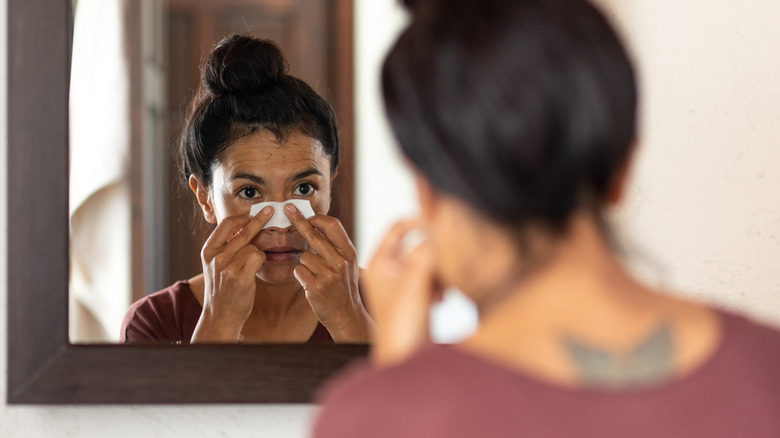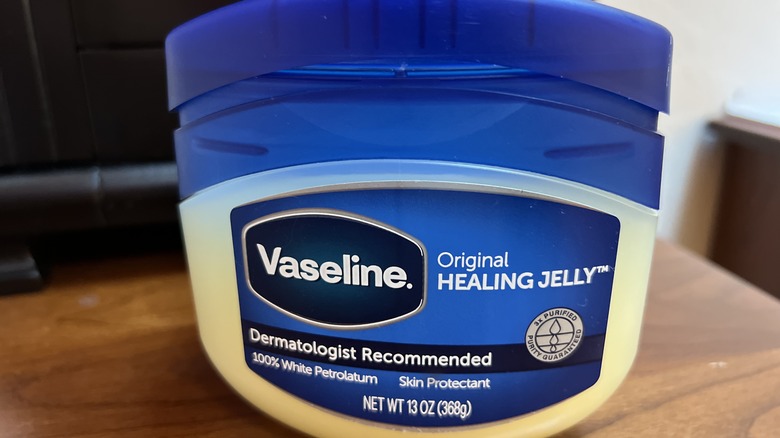What To Know Before Trying This This Plastic Wrap Hack To Remove Blackheads
Treating any form of acne (blackheads included) is one of those things for which the internet has so many hacks. Some are sound, while others border on being almost absurd.
When Korean beauty blogger Fei Yang posted a video about how she used Vaseline and plastic wrap (combined with one night's sleep) to remove blackheads from her nose, unsurprisingly, the reactions were mixed. Some followed suit and posted their reactions, while others started pointing out that Vaseline is actually comedogenic and can cause breakouts. Before discussing the effectiveness (or lack thereof) of this hack, let's break down the beauty influencer's formula. She starts off by applying a thick layer of Vaseline to her nose and cheeks, after which she uses saran wrap to seal up the space. "Tightly wrap the duck out of your nose," were Yang's exact words. Then she goes to bed for 10 hours. Once she wakes up and peels off the plastic wrap, she uses two Q-tips and goes to work on her nose. "Press them against each other, over and over (and over and over) again," she explains on the video. "You won't believe it, your junk just melts out instantly."
Quite honestly, watching her supposedly get rid of the blackheads on her nose may seem a bit painful, and according to board-certified dermatologist Dr. Purvisha Patel (via Daily Mail), one of the concerns with this hack is the repeated strain on the skin. "Overzealous blackhead squeezing can create inflammation, breakouts, and even scarring."
Is Vaseline comedogenic?
Vaseline is basically petroleum jelly, and according to board-certified dermatologist and YouTuber Dr. Andrea Suarez, Vaseline can actually be really beneficial for dry skin conditions like eczema. And no, it is not comedogenic.
The misinformation about petroleum jelly, also known as petrolatum, clogging your pores comes from people confusing cosmetic petroleum jelly with crude petroleum, shared Dr. Suarez. "Petrolatum that you buy in the store is what is called cosmetic-grade petrolatum. It is a by-product of dewaxing mineral oil and it's very safe. Now, if you were to go out to an oil refinery and put petroleum on your skin, that definitely will cause an acne rash," explained the skin expert.
Vaseline is just one brand name (perhaps the most commonly known) for petroleum jelly. There are several other cosmetic-grade petrolatum products, like CeraVe Healing Ointment and Aquaphor Healing Ointment, in the market. "Petroleum jelly is one of the safest products for the skin. It is safe on all skin types and has very little allergenic or irritant potential. It holds moisture in the skin and can help heal wounds," shared Dr. Lily Talakoub, a board-certified dermatologist based in Washington, D.C. (via Byrdie).
If you have very dry skin, eczema, want to heal scars or wounds, or even help retain moisture after harsh acne treatments with a soothing occlusive, petrolatum can be your go-to. But here are the concerns with Yang's hack to remove blackheads.
Sealing your face in plastic wrap overnight isn't the best idea
While covering a part of your skin with plastic wrap does create a moist and warm surface underneath that might be suitable for blackhead removal, one of the obvious hazards of this method is suffocation and stress on the skin, especially if you're going to sleep with the contraption. Plus, there is the chance that some products contain pore-clogging ingredients. As explained by Dr. Patel via the Daily Mail, "If you use products that are not straight petroleum jelly, it will end up with the opposite result — clogging pores and creating breakouts."
Also, according to San Francisco-based dermatologist Dr. William Kwan (via Health), there's a good chance that what Yang is calling blackheads are in fact sebaceous filament — sebum that's collected in your pores. "These can be easily extracted while in a warm shower by just using gentle pressure from your fingernails," explained the dermatologist.
Whether or not it's safe to extract blackheads at home really depends on your skin type, condition, and how careful you're willing to be. You might be better off following a consistent skincare routine that involves gentle cleansing with a salicylic acid or beta-hydroxy acid-based cleanser, retinoids for deeper pore cleansing, and extracting blackheads with a comedone extractor after a warm shower or steaming your face. If you're unsure about how to do careful and safe removal of blackheads, visit an esthetician from time to time for a professional facial treatment.


